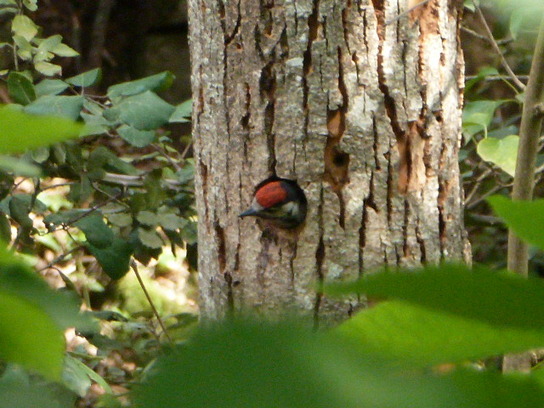The Albères hills provide an ideal habitat for all kinds of woodpeckers - the Great Spotted being the most common. You can hear them drumming from January onwards. There are some Green, but I get the impression they prefer the more open terrain of vineyards and orchards, perhaps because they are predominantly ground feeders.
Black woodpeckers are around too - mostly in winter apparently. But I had never heard or seen one until last year. And knowing how shy they were I never expected to find one at low altitude, close to human habitation. But one November day I was only about 200m above sea level when I heard a bizarre, mechanical-like call, coming from an isolated dead tree only a few metres ahead. There was that unmistakeable woodpecker profile against the trunk. It was BIG - jackdaw-sized - and totally black against the light. I couldn't see any red on its head. At that moment another rarity passed us: a van. The bird took off, calling again, and I had an excellent view of feathered tips to rounded wings. No white markings at all. Impossible to confuse with the Great Spotted or Green.
I'm used to hearing both of those, because of course they are common in Britain too, but now I realise all woodpecker species sound quite different from one another. The first time I listened to BBC Radio Four's Tweet of the Day (thanks to Isobel for telling me about it!), I did a double-take. That day's call was one I hear a lot in springtime and had always assumed was a kestrel. On one occasion I had stood directly beneath the tree the bird was calling from, and still couldn't spot it. That was because I was looking for the wrong bird. I should have been searching for a brown woodpecker the size of a greenfinch. The Wryneck.
My book says these are summer migrants to this area, so when I started hearing that same call again last month, I was determined to confirm once and for all that it was indeed the Wryneck. They are, however, notoriously hard to spot.
As I said in my blog about the Lammergeiers, you can never be certain of finding exactly what you're after (rather like shopping for a special outfit). But I thought I knew where one might hang out.
As soon as I got out of the car I heard it, tantalisingly close-by.
Here's a recording. The Wryneck starts about 11 seconds in. Doesn't sound much like a kestrel at all, does it? You can also hear plenty of other small birds and, in the distance, a crow (less common than ravens in the Albères!).
Just when I found I was leaning on an ant runway, the call came again, from a tree only about three metres away. It was right there, about two-thirds of the way up, not moving; but could I see it? Must have been on the side facing away from me, or hidden by leaves. Finally something small flew to another tree not far away. I marked it, crept closer - twigs snapping like gunshots beneath my delicate footfall - and finally got it with the naked eye.
A very busy little chap, moving rather like a nuthatch (eye-stripe like a nuthatch too). I just got the binos focused when it was joined by another. A brief kerfuffle followed. Part of a courtship ritual or two males disputing territory?
They were fleeting glimpses, but the birds were just as intricately and beautifully patterned as illustrated in my book. Lighter brown though - almost golden - so they showed up against the bark better than expected. Sweet things, that didn't seem bothered by my presence. I didn't hang around too long, though, in case they were nesting there.
I was sure that would be the pinnacle of my woodpecker experiences for this year. But I was wrong. A few days ago (yet another windy one) I stopped at a corner on the forest track to give my dogs some water. While they tried to make up their minds if they were thirsty after all, I heard what sounded like an animal moving through the undergrowth in a gully down to my left. The dogs showed no interest so I decided it was nothing - probably a blackbird masquerading as a wild boar. But then the tchik tchik alarm of a Great Spotted Woodpecker started up. Something was going on, but what? I moved to the edge of the track and peered through a gap in the foliage. Hard to see anything but tree trunks and leaves.
Until I caught a flash of black, white and red on a dead tree some yards away. Undoubtedly a woodpecker, but tiny. Could this be my first ever sighting of the sparrow-sized Lesser Spotted? (We're on the very edge of the main part of its range.) My hopes were short-lived when a much larger woodpecker landed on the trunk next to the small one. And that's when I realised that what I had stumbled upon was this (with apologies for camera shake!):
And here's his sister,
equally curious about the world outside:
|
They were much further away than the photos suggest, so I wasn't disturbing them. One or other parent returned every so often. I assumed this was to feed them. Unless it was to encourage them to leave the nest? Unfortunately they kept timing their visits to coincide with another strong gust that blew leafy branches in front of the camera lens, so I'm sorry I didn't capture the best moment.
But what a treat! And how lucky. When I walked that way again today, they had gone. Fledged. |

